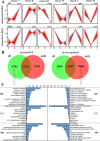A multi-omics approach identifies bHLH71-like as a positive regulator of yellowing leaf pepper mutants exposed to high-intensity light
- PMID: 37426880
- PMCID: PMC10323627
- DOI: 10.1093/hr/uhad098
A multi-omics approach identifies bHLH71-like as a positive regulator of yellowing leaf pepper mutants exposed to high-intensity light
Abstract
Light quality and intensity can have a significant impact on plant health and crop productivity. Chlorophylls and carotenoids are classes of plant pigments that are responsible for harvesting light energy and protecting plants from the damaging effects of intense light. Our understanding of the role played by plant pigments in light sensitivity has been aided by light-sensitive mutants that change colors upon exposure to light of variable intensity. In this study, we conducted transcriptomic, metabolomic, and hormone analyses on a novel yellowing mutant of pepper (yl1) to shed light on the molecular mechanism that regulates the transition from green to yellow leaves in this mutant upon exposure to high-intensity light. Our results revealed greater accumulation of the carotenoid precursor phytoene and the carotenoids phytofluene, antheraxanthin, and zeaxanthin in yl1 compared with wild-type plants under high light intensity. A transcriptomic analysis confirmed that enzymes involved in zeaxanthin and antheraxanthin biosynthesis were upregulated in yl1 upon exposure to high-intensity light. We also identified a single basic helix-loop-helix (bHLH) transcription factor, bHLH71-like, that was differentially expressed and positively correlated with light intensity in yl1. Silencing of bHLH71-like in pepper plants suppressed the yellowing phenotype and led to reduced accumulation of zeaxanthin and antheraxanthin. We propose that the yellow phenotype of yl1 induced by high light intensity could be caused by an increase in yellow carotenoid pigments, concurrent with a decrease in chlorophyll accumulation. Our results also suggest that bHLH71-like functions as a positive regulator of carotenoid biosynthesis in pepper.
© The Author(s) 2023. Published by Oxford University Press on behalf of Nanjing Agricultural University.
Conflict of interest statement
None declared.
Figures







References
-
- Susila H, Jin S, Ahn JH. Light intensity and floral transition: chloroplast says "time to flower!". Mol Plant. 2016;9:1551–3. - PubMed
-
- Chen M, Chory J, Fankhauser C. Light signal transduction in higher plants. Annu Rev Genet. 2004;38:87–117. - PubMed
-
- Liu H, Yu X, Li Ket al. . Photoexcited CRY2 interacts with CIB1 to regulate transcription and floral initiation in Arabidopsis. Science. 2008;322:1535–9. - PubMed
LinkOut - more resources
Full Text Sources

